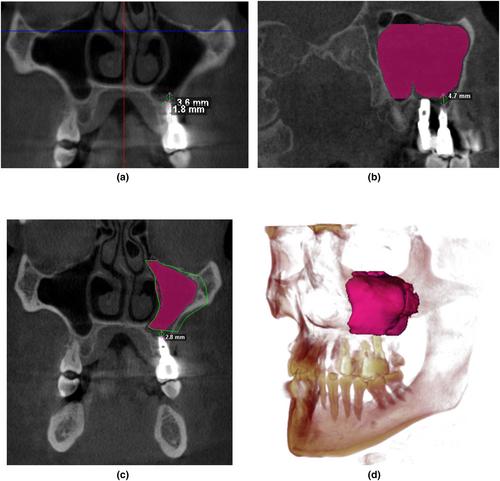Peri-implantitis and maxillary sinus membrane thickening: A retrospective cohort study
Abstract
Objective
The objective of this study is to investigate the association of peri-implantitis (PI) and sinus membrane thickening and to assess the resolution of membrane thickening following intervention (implant removal or peri-implantitis treatment) aimed at arresting PI.
Materials and Methods
Forty-five patients with 61 implants in the posterior maxillary region were retrospectively included in the study. Twenty-four patients were diagnosed with peri-implantitis (PI) and 21 had peri-implant health (PH). Cone-beam computed tomography (CBCT) scans were evaluated to assess maxillary sinus characteristics, including membrane thickening, sinus occupancy and ostium patency. The CBCT scans taken 6 months after intervention aimed at arresting disease (implant removal or treatment of PI) in the PI group were also appraised and compared to baseline scans.
Results
At baseline, all parameters evaluating membrane thickness disorders yielded significant differences between groups (p < .001). Patients with posterior maxillary implants diagnosed with PI were 7× more likely to present membrane thickening compatible with pathology when compared to patients with healthy implants (OR = 7.14; p = .005). Furthermore, the likelihood was 6x greater in implants diagnosed with PI to exhibit moderate membrane thickening (OR = 6.75, p = .001). The patients receiving interventions aimed at arresting PI experienced significant enhancement in all radiographic parameters related to the sinus cavity at the 6-month follow-up (p < .001), though these variations were similarly independent of whether treatment consisted of PI treatment or implant removal.
Conclusions
Maxillary sinus membrane thickening and the permeability/obstruction of the ostium are frequently associated with the presence of PI in posterior implants. Interventions targeting disease resolution effectively reduce membrane thickness to levels compatible with maxillary sinus health.


 求助内容:
求助内容: 应助结果提醒方式:
应助结果提醒方式:


